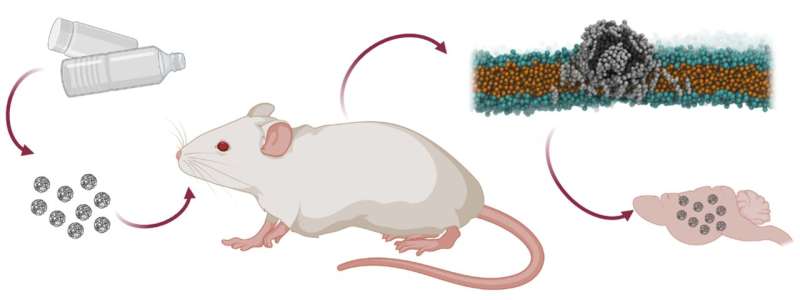This article has been reviewed according to Science X's editorial process and policies. Editors have highlighted the following attributes while ensuring the content's credibility:
fact-checked
trusted source
proofread
Study shows how tiny plastic particles manage to breach the blood-brain barrier

Among the biggest environmental problems of our time, micro- and nanoplastic particles (MNPs) can enter the body in various ways, including through food. And now for the first time, research conducted at MedUni Vienna has shown how these minute particles manage to breach the blood-brain barrier and as a consequence penetrate the brain. The newly discovered mechanism provides the basis for further research to protect humans and the environment.
Published in the journal Nanomaterials, the study was carried out in an animal model with oral administration of MNPs, in this case polystyrene, a widely-used plastic which is also found in food packaging. Led by Lukas Kenner (Department of Pathology at MedUni Vienna and Department of Laboratory Animal Pathology at Vetmeduni) and Oldamur Hollóczki (Department of Physical Chemistry, University of Debrecen, Hungary) the research team was able to determine that tiny polystyrene particles could be detected in the brain just two hours after ingestion.
The mechanism that enabled them to breach the blood-brain barrier was previously unknown to medical science. "With the help of computer models, we discovered that a certain surface structure (biomolecular corona) was crucial in enabling plastic particles to pass into the brain," Oldamur Hollóczki explained.
Researching impact on health
The blood-brain barrier is an important cellular barrier that prevents pathogens or toxins from reaching the brain. The intestine has a similar protective wall (intestinal barrier), which can also be breached by MNPs, as various scientific studies have demonstrated. Intensive research is being conducted on the health effects of plastic particles in the body. MNPs in the gastrointestinal tract have already been linked with local inflammatory and immune reactions, and the development of cancer.
"In the brain, plastic particles could increase the risk of inflammation, neurological disorders or even neurodegenerative diseases such as Alzheimer's or Parkinson's," said Lukas Kenner, pointing out that more research is needed in this area.
Restrict the use of MNPs
Nanoplastics are defined as having a size of less than 0.001 millimeters, while at 0.001 to 5 millimeters, some microplastics are still visible to the naked eye. MNPs enter the food chain through various sources including packaging waste.
But it is not just solid food that plays a role, but liquids too: according to one study, anyone who drinks the recommended 1.5-2 liters of water per day from plastic bottles will end up ingesting around 90,000 plastic particles a year in the process. However, drinking tap water instead can—depending on the geographical location—help reduce this figure to 40,000.
"To minimize the potential harm of micro- and nanoplastic particles to humans and the environment, it is crucial to limit exposure and restrict their use while further research is carried out into the effects of MNPs," Lukas Kenner explained. The newly discovered mechanism by which MNPs breach protective barriers in the body has the potential to advance research in this area decisively.
More information: Verena Kopatz et al, Micro- and Nanoplastics Breach the Blood–Brain Barrier (BBB): Biomolecular Corona's Role Revealed, Nanomaterials (2023). DOI: 10.3390/nano13081404
Provided by Medical University of Vienna



















